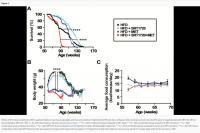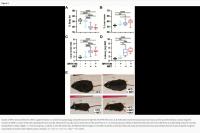.
S O U R C E : The Journals of Gerontology
Abstract
SRT1720, a sirtuin1-activator, and metformin (MET), an antidiabetic drug, confer health and life-span benefits when administered individually. It is unclear whether combination of the two compounds could lead to additional benefits. Groups of 56-week-old C57BL/6J male mice were fed a high-fat diet (HFD) alone or supplemented with either SRT1720 (2 g/kg food), a high dose of MET (1% wt/wt food), or a combination of both. Animals were monitored for survival, body weight, food consumption, body composition, and rotarod performance. Mice treated with MET alone did not have improved longevity, and life span was dramatically reduced by combination of MET with SRT1720. Although all groups of animals were consuming similar amounts of food, mice on MET or MET + SRT1720 showed a sharp reduction in body weight. SRT1720 + MET mice also had lower percent body fat combined with better performance on the rotarod compared to controls. These data suggest that co-treatment of SRT1720 with MET is detrimental to survival at the doses used and, therefore, risk-benefits of combining life-span-extending drugs especially in older populations needs to be systematically evaluated.
Pharmacological stimulation of sirtuins (a family of NAD+-dependent deacetylases) elicits several benefits for life-span and health extension (1). Sirtuin 1 (SIRT1) activation extends life span and health in model organisms (2,3). Small molecules such as resveratrol activate SIRT1 and trigger cellular signaling leading to improved mitochondrial biogenesis (4) and reduced inflammation (5). Studies have shown that SRT2104, an allosteric SIRT1 activator, preserves bone and muscle mass and extends survival of male mice on standard diet (SD) (6). SRT1720, another SIRT1 activator, improves healthspan and increases survival of middle-aged mice on SD (7) and on high-fat diet (HFD) (8). SRT1720 also improves glucose homeostasis and insulin sensitivity in mouse and rat models of type 2 diabetes (T2D) (3). Some of these SIRT1 activators have also been tested in clinical trials, mostly for metabolic conditions such as T2D, with some encouraging results (9), making the use of SIRT1 activators clinically relevant.
Metformin (MET) is a biguanide commonly used as the first line of treatment for T2D, as it reduces hepatic gluconeogenesis and increases insulin sensitivity and glycolysis. MET has also been proposed for weight loss in people that are overweight who do not have T2D (10). We previously showed that daily treatment of aged mice fed SD with 0.1% MET elicited a small but significant extension in longevity, whereas 1% MET (high dose, ~500 mg/kg body weight) resulted in a marked reduction in survival (11). We also showed that intermittent consumption of 1% MET improved metabolic parameters in SD-fed middle-aged mice without reduction in life span, although the MET-treated mice still exhibited some kidney issues (12). Within the interventions testing program, 0.1% MET lead to a nonsignificant 7% increase in median life span in only male mice when data from multiple study sites were combined (13). Other reports have shown that 100 mg MET/kg body weight (~0.2% MET) mediates beneficial geroprotective effects in female mice (14). Even though 1% MET resulted in life-span reduction, it strongly mimics transcriptomic changes elicited by caloric restriction (CR) (11,15), which prompted the investigation of alternative strategies to circumvent adverse effects of high dose MET.
Combining small molecules has been a successful strategy to obtain better efficacy, decreased toxicity, and reduced drug resistance (16). Mixtures and combinations of two or more compounds have been proposed as anti-aging interventions (17). Based on this, we tested the hypothesis that the combination of SRT1720 with MET may alleviate some of the adverse outcomes of 1% MET, while conferring synergistic benefits on health and survival in a cohort of aged mice fed HFD.
.../...
Results
Treatment with SRT1720 significantly improved median survival (103 weeks vs 115 weeks, p < .0001) without maximum life-span extension, while MET alone had no impact on life-span in HFD-fed mice (Figure 1A; Supplementary Table S1). Mice on the combination MET + SRT1720 exhibited a dramatic reduction both in median (84 weeks) and maximum (~100–105 weeks) life span, with a ~35% reduction in maximum life span compared to HFD controls (Figure 1A). Glomerulonephrosis (characterized by enlarged, discolored, and lumpy kidneys) was observed in 24% of the MET-treated mice during necropsy as per previous reports about high doses of MET associating with renal problems in mice (12). Glomerulonephrosis incidence was markedly higher in the combination group (Supplementary Figure S1), although pathological characterization of these kidneys was not performed.
Figure 1.
Compared to controls, mice on SRT1720 exhibited a modest reduction in body weight gain in the early phase of the protocol, whereas MET and MET + SRT1720 mice steadily lost weight (Figure 1B). Body weight of mice in the combination group at the beginning was slightly lower than the other groups in the study, an effect we believe to be random but warrants acknowledgment. No significant differences in food consumption were observed (Figure 1C). Food consumption was not measured beyond 70 weeks as mice in the combination group started to rapidly die and measurements during this time would have been directly impacted by moribundity.
Several functional measurements were performed to characterize health status. Testing was done only at 64 and 68 weeks of age to limit stress imposed on them. Amount of whole-body fat and lean mass were obtained from NMR spectroscopy in live animals after 8 weeks on diet (64 weeks old). SRT1720 mice had a similar percent body fat and lean mass as controls while mice on MET alone or combined with SRT1720 showed a significant reduction in percent body fat (Figure 2A), coincident with an increase in percent lean mass (Figure 2B) and lean-to-fat ratio (Figure 2C). Motor coordination was measured using the accelerating rotarod at 68 weeks of age, where results indicated that SRT1720 had no beneficial effects while MET alone and the combination SRT1720 + MET significantly improved performance versus HFD controls (Figure 2D). Control and SRT1720-treated mice on HFD became obese in comparison to those maintained on MET alone or combination, with the latter groups of mice remaining lean after 26 weeks on diet (82 weeks old) (Figures 1B and 2E).
Figure 2.
Discussion
Over the past decades, different pharmacologic agents have shown to exert prolongevity benefits through a variety of related but distinct mechanisms. As such, combination of different life-span-extending compounds is regarded as a promising way to achieve effective anti-aging. However, we found that mice fed an obesogenic diet supplemented with MET + SRT1720 died prematurely with a severe drop in body weight without loss of appetite. It is not clear whether these dramatic differences in body weight are due to changes in heat production, ambulatory activity, gut absorption, or a number of other factors that could be involved in promoting these effects. No signs of diarrhea, enhanced anxiety, or activity were observed in these animals during this experiment. Although detrimental to survival, mice on MET + SRT1720 were leaner and performed significantly better on the accelerating rotarod than their age-matched controls or SRT1720 mice, suggesting that the drug combination, at the administered doses, were effective at conferring a strong biological response.
.../...
.














































